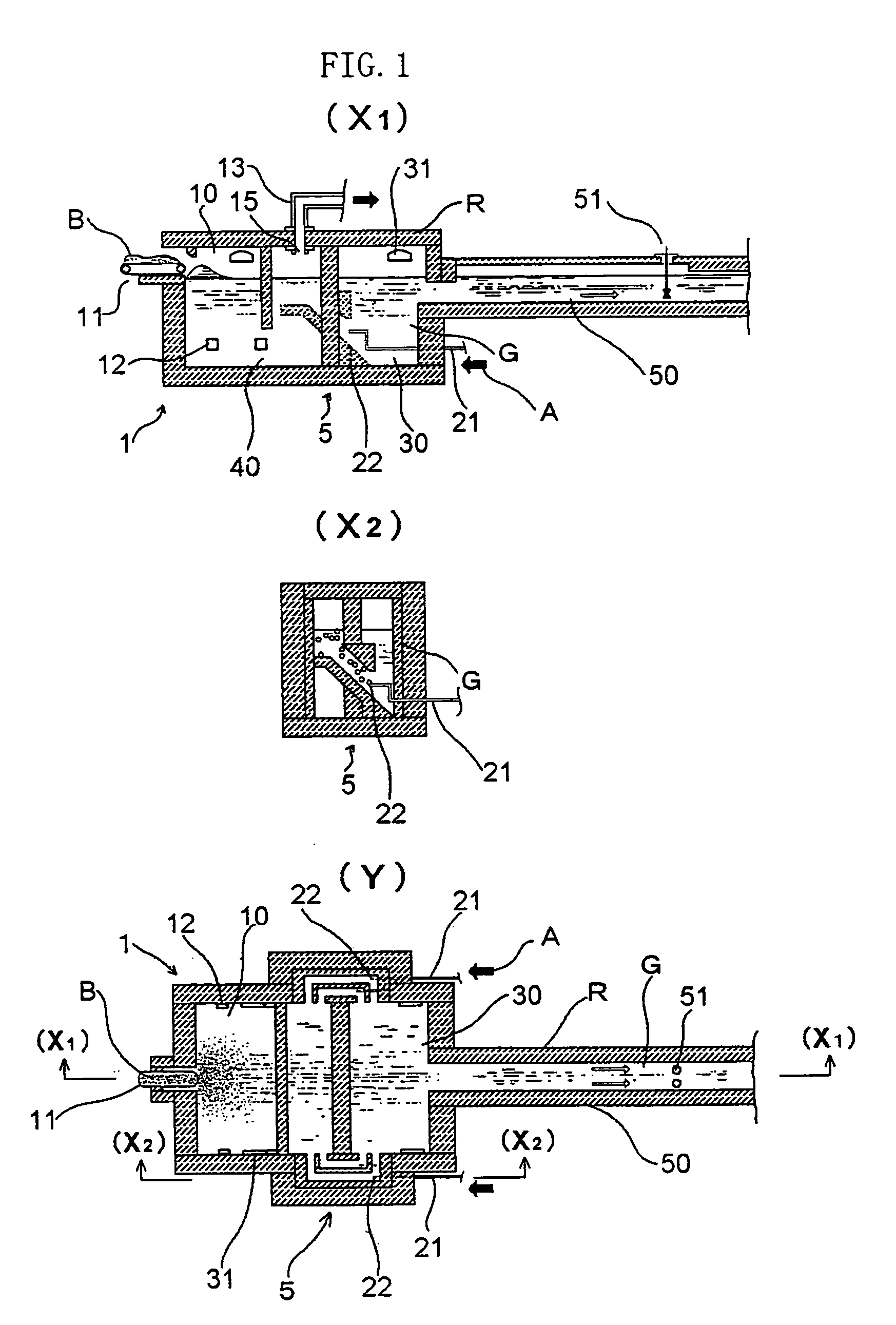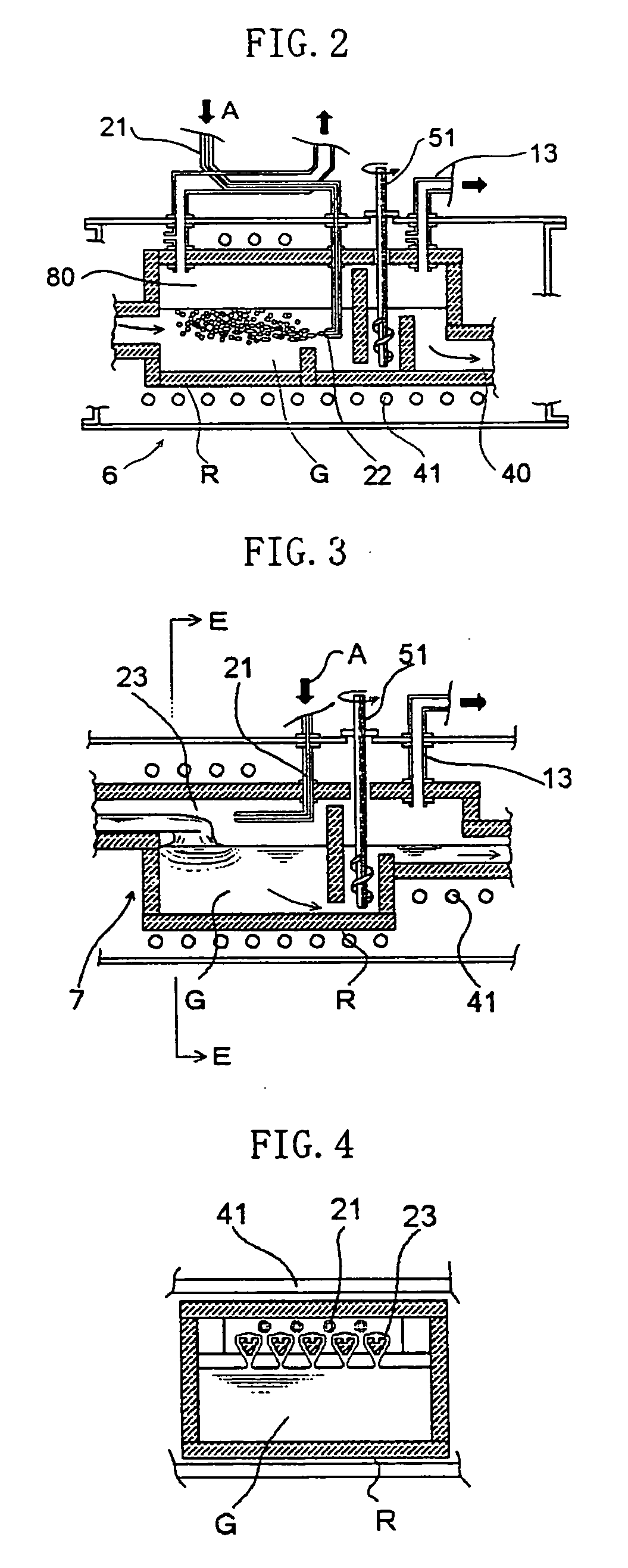Glass melting gurnace and method for producing glass
a glass melting furnace and glass technology, applied in glass pressing apparatus, glass making apparatus, manufacturing tools, etc., can solve the problems of affecting factors, affecting the efficiency of homogenizing molten glass, and limiting the melting furnace, so as to achieve stable quality, easy to introduce helium or neon, and easy to adjust the volume of molten glass introducing.
- Summary
- Abstract
- Description
- Claims
- Application Information
AI Technical Summary
Benefits of technology
Problems solved by technology
Method used
Image
Examples
embodiment 1
[0107] The inventors of the present invention have attempted to improve product yield than before by: applying the glass melting furnace of the present invention as a melting device for a glass product, which is silicate glass of a composition having an alkali content of 10 mass % or less and used as sheet glass for electronic components; and assuredly performing fining of the glass. The glass melting furnace of the present invention was realized by providing a noble gas dissolving device as noble gas dissolving means for diffusing and mixing, and dissolving helium and / or neon into molten glass, between a melting tank and fining chamber of a small continuous melting furnace conventionally used. FIG. 1 shows a constitution of a glass melting furnace 1. A refractory wall is provided between a melting tank 10 and a fining chamber 30. Molten glass G in the melting tank 10 flows into the fining chamber 30 through two noble gas dissolving devices 5 {see FIG. 1(Y)} respectively connected t...
embodiment 2
[0112] Next, an embodiment employing a constitution suitable for melting a glass material having easier properties of diffusion and mixing, and dissolution of helium and / or neon into the molten glass compared with Embodiment 1 as a glass melting furnace for tubular glass used for electronic components is described.
[0113] The melting furnace is very small as a continuous melting furnace, and has a disadvantage that unreacted raw material components are apt to flow out to the fining chamber because of a small volume of the melting tank. In order to overcome the disadvantage, the melting furnace employs a structure having a noble gas dissolving device connected downstream of the melting tank. FIG. 2 shows a partially sectional view of a noble gas dissolving device 6 employed in the glass melting furnace.
[0114] The molten glass G melted in the melting tank flows into the noble gas dissolving device 6 from the left side of FIG. 2. Meanwhile, the helium gas A is introduced in an opposit...
embodiment 3
[0118] Next, an embodiment employing a glass melting furnace of the present invention as an apparatus for manufacturing display glass is described. Because bubbles in an image display part are highly visible, glass products used for such an application require stricter management of bubble quality than that of glass products used for other applications, and bubbles are perceived as critical defects. FIG. 3 shows a longitudinal sectional view of a noble gas dissolving device 7 provided in the glass melting furnace of the present invention, and FIG. 4 shows a transverse sectional view of the E part of FIG. 3. The raw materials charged into the melting tank are melted by heating with a burner and by direct heating with a platinum electrode, and the molten glass G flows into the noble gas dissolving device 7 from the left side of FIG. 3. As shown in FIGS. 3 and 4, heat resistant tubs 23 are provided inside the noble gas dissolving device 7. While the molten glass G flows along the heat ...
PUM
| Property | Measurement | Unit |
|---|---|---|
| vector angle | aaaaa | aaaaa |
| vector angle | aaaaa | aaaaa |
| vector angle | aaaaa | aaaaa |
Abstract
Description
Claims
Application Information
 Login to View More
Login to View More - R&D
- Intellectual Property
- Life Sciences
- Materials
- Tech Scout
- Unparalleled Data Quality
- Higher Quality Content
- 60% Fewer Hallucinations
Browse by: Latest US Patents, China's latest patents, Technical Efficacy Thesaurus, Application Domain, Technology Topic, Popular Technical Reports.
© 2025 PatSnap. All rights reserved.Legal|Privacy policy|Modern Slavery Act Transparency Statement|Sitemap|About US| Contact US: help@patsnap.com



